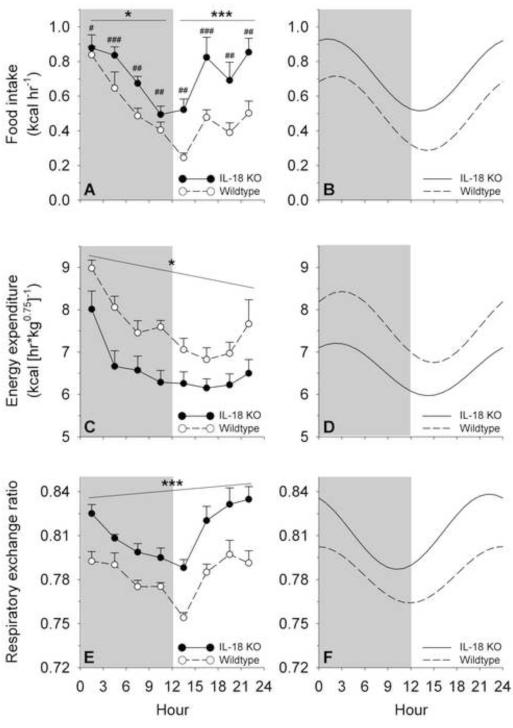Figure 2.
Circadian time course of food intake, energy expenditure and respiratory exchange ratio in high-fat diet-fed interleukin-18 knockout (IL-18 KO) and wildtype (WT) mice. Data express M (+SEM) rates of food intake (Panel A), weight-normalized energy expenditure (C) and average respiratory exchange ratios (E) of mature female mice averaged across 3-hr bins during a daily observation period in indirect calorimetry chambers. Panels B, D and F show the respective cosinor functions, interpolated from the observed data; cosinor parameters are presented in Table 3. The grey shading indicates the dark cycle. Panels A and B illustrate that IL-18 KO mice ate significantly more high-fat diet than WT mice; this difference was even greater during the light cycle than dark cycle and was reflected in an increased circadian MESOR, peak and nadir. Genotype differences pooled across the cycle *p = 0.06, ***p < 0.0001 (Genotype × Cycle interaction followed by Fisher’s protected least significance difference tests); pooled across corresponding bins #p < 0.05, ##p < 0.005, ###p < 0.001 (Genotype × Bin interaction followed by Fisher’s protected least significance difference tests). Panels C and D show that IL-18 KO mice expended significantly less energy than WT mice across the entire day and also had a blunted circadian rhythm; these differences were reflected in a reduced circadian amplitude, MESOR, peak and nadir. *p < 0.05, Genotype main effect. Panels E and F show that IL-18 KO mice had greater mean respiratory exchange ratios than WT mice across the entire light/dark cycle, differences that were reflected in an increased circadian MESOR, peak and nadir. ***p < 0.001, Genotype main effect. Genotypes did not differ in the acrophase of rhythms.

